Distribution of oxidized DJ-1 in Parkinson's disease-related sites in the brain and in the peripheral tissues: effects of aging and a neurotoxin
- PMID: 30104666
- PMCID: PMC6089991
- DOI: 10.1038/s41598-018-30561-z
Distribution of oxidized DJ-1 in Parkinson's disease-related sites in the brain and in the peripheral tissues: effects of aging and a neurotoxin
Abstract
DJ-1 plays an important role in antioxidant defenses, and a reactive cysteine at position 106 (Cys106) of DJ-1, a critical residue of its biological function, is oxidized under oxidative stress. DJ-1 oxidation has been reported in patients with Parkinson's disease (PD), but the relationship between DJ-1 oxidation and PD is still unclear. In the present study using specific antibody for Cys106-oxidized DJ-1 (oxDJ-1), we analyzed oxDJ-1 levels in the brain and peripheral tissues in young and aged mice and in a mouse model of PD induced using 1-methyl-4-phenyl-1,2,3,6-tetrahydropyridine (MPTP). OxDJ-1 levels in the brain, heart, and skeletal muscle were high compared with other tissues. In the brain, oxDJ-1 was detected in PD-related brain sites such as the substantia nigra (SN) of the midbrain, olfactory bulb (OB), and striatum. In aged wild-type mice, oxDJ-1 levels in the OB, striatum, and heart tended to decrease, while those in the skeletal muscle increased significantly. Expression of dopamine-metabolizing enzymes significantly increased in the SN and OB of aged DJ-1-/- mice, accompanied by a complementary increase in glutathione peroxidase 1. MPTP treatment concordantly changed oxDJ-1 levels in PD-related brain sites and heart. These results indicate that the effects of physiological metabolism, aging, and neurotoxin change oxDJ-1 levels in PD-related brain sites, heart, and skeletal muscle where mitochondrial load is high, suggesting a substantial role of DJ-1 in antioxidant defenses and/or dopamine metabolism in these tissues.
Conflict of interest statement
The authors declare no competing interests.
Figures
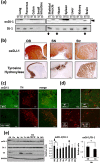
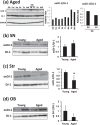
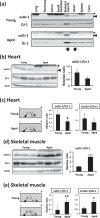
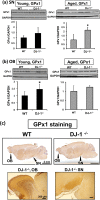
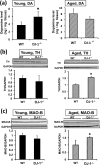


Similar articles
-
Redox modulatory role of DJ-1 in Parkinson's disease.Biogerontology. 2025 Mar 30;26(2):81. doi: 10.1007/s10522-025-10227-w. Biogerontology. 2025. PMID: 40159591 Review.
-
DJ-1 as a Biomarker of Parkinson's Disease.Adv Exp Med Biol. 2017;1037:149-171. doi: 10.1007/978-981-10-6583-5_10. Adv Exp Med Biol. 2017. PMID: 29147908
-
DJ-1-dependent protective activity of DJ-1-binding compound no. 23 against neuronal cell death in MPTP-treated mouse model of Parkinson's disease.J Pharmacol Sci. 2015 Mar;127(3):305-10. doi: 10.1016/j.jphs.2015.01.010. Epub 2015 Feb 20. J Pharmacol Sci. 2015. PMID: 25837927
-
Surprising behavioral and neurochemical enhancements in mice with combined mutations linked to Parkinson's disease.Neurobiol Dis. 2014 Feb;62:113-23. doi: 10.1016/j.nbd.2013.09.009. Epub 2013 Sep 26. Neurobiol Dis. 2014. PMID: 24075852 Free PMC article.
-
Expression of DJ-1 in Neurodegenerative Disorders.Adv Exp Med Biol. 2017;1037:25-43. doi: 10.1007/978-981-10-6583-5_3. Adv Exp Med Biol. 2017. PMID: 29147901 Review.
Cited by
-
The Overcrowded Crossroads: Mitochondria, Alpha-Synuclein, and the Endo-Lysosomal System Interaction in Parkinson's Disease.Int J Mol Sci. 2019 Oct 25;20(21):5312. doi: 10.3390/ijms20215312. Int J Mol Sci. 2019. PMID: 31731450 Free PMC article. Review.
-
A mitochondria-targeted caffeic acid derivative reverts cellular and mitochondrial defects in human skin fibroblasts from male sporadic Parkinson's disease patients.Redox Biol. 2021 Sep;45:102037. doi: 10.1016/j.redox.2021.102037. Epub 2021 Jun 8. Redox Biol. 2021. PMID: 34147843 Free PMC article.
-
Human Periapical Cyst-Derived Stem Cells Can Be A Smart "Lab-on-A-Cell" to Investigate Neurodegenerative Diseases and the Related Alteration of the Exosomes' Content.Brain Sci. 2019 Dec 5;9(12):358. doi: 10.3390/brainsci9120358. Brain Sci. 2019. PMID: 31817546 Free PMC article.
-
Redox modulatory role of DJ-1 in Parkinson's disease.Biogerontology. 2025 Mar 30;26(2):81. doi: 10.1007/s10522-025-10227-w. Biogerontology. 2025. PMID: 40159591 Review.
-
Mitochondrial Function and Parkinson's Disease: From the Perspective of the Electron Transport Chain.Front Mol Neurosci. 2021 Dec 9;14:797833. doi: 10.3389/fnmol.2021.797833. eCollection 2021. Front Mol Neurosci. 2021. PMID: 34955747 Free PMC article. Review.
References
-
- Ariga, H. & Iguchi-Ariga, M. M. S. DJ-1/PARK7 Protein. Springer Nature Shingapore: Adv. Exp. Med. Biol. 1037 (2017)
Publication types
MeSH terms
Substances
LinkOut - more resources
Full Text Sources
Other Literature Sources
Medical
Molecular Biology Databases
Research Materials
Miscellaneous

